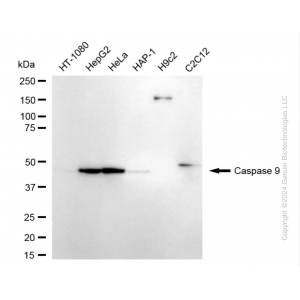| Reactivity: | Human, Mouse |
| Applications: | WB, FC, IC |
| Host Species: | Rabbit |
| Isotype: | IgG |
| Clonality: | Monoclonal antibody |
| Gene Name: | caspase 9 |
| Gene Symbol: | CASP9 |
| Synonyms: | MCH6; APAF3; APAF-3; PPP1R56; ICE-LAP6 |
| Gene ID: | 842 |
| UniProt ID: | P55211 |
| Clone ID: | 24GB4285 |
| Immunogen: | A synthesized peptide derived from human Caspase-9 |
| Dilution: | WB 1:1,000-1:5,000; FC 1:2,000; IC 1:100-1:1,000 |
| Purification Method: | Affinity purified |
| Concentration: | Lot dependent |
| Buffer: | PBS with 0.02% sodium azide, 50% glycerol, pH7.3. |
| Storage: | Store at -20°C. Avoid freeze/thaw cycles. |
Background
This gene CASP9 encodes a member of the cysteine-aspartic acid protease (caspase) family. Sequential activation of caspases plays a central role in the execution-phase of cell apoptosis. Caspases exist as inactive proenzymes which undergo proteolytic processing at conserved aspartic residues to produce two subunits, large and small, that dimerize to form the active enzyme. This protein can undergo autoproteolytic processing and activation by the apoptosome, a protein complex of cytochrome c and the apoptotic peptidase activating factor 1; this step is thought to be one of the earliest in the caspase activation cascade. This protein is thought to play a central role in apoptosis and to be a tumor suppressor. Alternative splicing results in multiple transcript variants.
Images
 | Western blotting analysis using anti-caspase 9 antibody (Cat#63156). Total cell lysates (30 μg) from various cell lines were loaded and separated by SDS-PAGE. The blot was incubated with anti-caspase 9 antibody (Cat#63156, 1:5,000) and HRP-conjugated goat anti-rabbit secondary antibody (Cat#201, 1:20,000) respectively. Image was developed using NaQ™ ECL Substrate Kit (Cat#716). |
 | Western blotting analysis using anti-caspase 9 antibody (Cat#63156). Caspase 9 expression in wild type (WT) and caspase 9 (CASP9) shRNA knockdown (KD) C2C12 cells with 20 μg of total cell lysates. Hsp90 α serves as a loading control. The blot was incubated with anti-caspase 9 antibody (Cat#63156, 1:5,000) and HRP-conjugated goat anti-rabbit secondary antibody (Cat#201, 1:20,000) respectively. Image was developed using NaQ™ ECL Substrate Kit (Cat#716). |
 | Flow cytometric analysis of Caspase 9 expression in HepG2 cells using anti-Caspase 9 antibody (Cat#63156, 1:2,000). Green, isotype control; red,Caspase 9. |
 | Immunocytochemical staining of HepG2 cells with anti-Caspase 9 antibody (Cat#63156, 1:1,000). Nuclei were stained blue with DAPI; Caspase 9 was stained magenta with Alexa Fluor® 647. Images were taken using Leica stellaris 5. Protein abundance based on laser Intensity and smart gain: Low. Scale bar, 20 μm. |
You may also be interested in:

